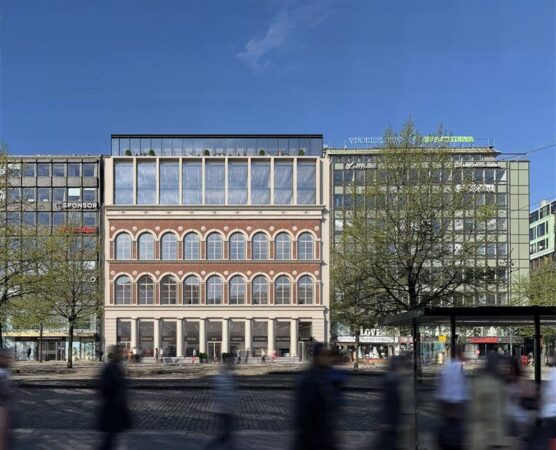
Sponda develops historic buildings in the city centre: “Buildings of historic value make up the identity of our city”
Real estate development company Sponda owns 13 historic buildings that are more than 100 years old in the city centre of Helsinki. What does the repair and maintenance of these historic buildings require, and why is it so important for the entire city to cherish them?
The historic Fennia building, masterpiece of renaissance revival Bulevardi 1, the art nouveau castle Koitto building, the Gymnasium of Alexander, built by Alexander II of Russia, and the Capitol cinema building, representative of 1920s classicism. All these buildings are more than 100 years old and owned by Sponda. With their decorative facades and beautiful arched windows, they create a unique setting for the city centre of Helsinki.
“As a major real estate owner in the city centre, we have a significant responsibility in tending to the historic buildings, as well as saving and passing on their cultural heritage. Having vibrant historic buildings with services and facilities also increases the attractiveness and pull of the city centre,” explains Sampo Ahlsten, Director, Development at Sponda.

Quality also under the surface
Expert in green conservation Sitowise is Sponda’s partner in developing the valuable buildings. Sitowise’s Director of Development Tuomas Pakka says that both versatile skills and large investments are required when repairing historic buildings.
“The interpretation of old plans and unique solutions requires you to understand the various eras, technical building services and architecture. You also need to do a lot of research. The renovation of a building of historic value always begins with a building history survey, condition surveys, harmful substance surveys and project planning,” Pakka says.

According to Pakka, cost estimates will often reach millions of euros in labour-intensive renovation projects. The more carefully the job is done, the bigger the investment needs to be. On the other hand, renovation repays itself in the building’s lifecycle costs and reduced repair needs – while also increasing the building’s sale and security value.
“I am happy to take part in Sponda’s projects, as the renovation is carried out in accordance with the strictest responsibility and quality criteria. The solutions that remain beneath the surface are also realised with high quality, and they aim to make even the older buildings as energy efficient and low-carbon as possible.”
Fennia – a tribute to the entire city
One example of Sponda’s projects that Pakka mentions is the renewal of the Fennia block by the Railway Square. Since its construction, the building was renovated multiple times, and its use had changed. The impressive facade of the protected Fennia building had fallen into decay.

“Restoring the neo-baroque facade of the Fennia building was one of the greatest projects of my career. We spent a lot of time restoring the facade, which is significant in terms of both its architecture and the cityscape. Each historic detail was realised reverently and carefully following the original architecture.”
The nearly 50-million-euro block renewal was also a significant investment in the improvement of the building’s energy efficiency, the renewal of technical building services and the restoration of the facilities.
In early 2023, the building achieved full carbon-neutrality in terms of energy consumption during use, and its annual cardon dioxide emissions decreased by nearly 4,000 tonnes during the development. A new restaurant experience Ruoka & Mat, increasing the vibrancy of the entire area, also opened its doors in the historic block.
One of the most challenging projects in Finland
Pakka also highlights the renovation of the Eliel Saarinen building in the very heart of Helsinki. A large facade and roof renovation was carried out in the historic building in the inner courtyard of the Citycenter shopping centre in 2017 and 2021.

“The project was an example of how ambitious planning and good cooperation are necessary for the realisation of a significant renewal, improving the cityscape, in a challenging location. The courtyard is active around the clock and must have been Finland’s most difficult work location for the contractors, and most of the work had to be carried out at night,” Pakka says.
Other valuable buildings in the centre of Helsinki that Sponda has renovated to their full splendour in recent years are Arkadia 6, Mannerheimintie 16 and Yrjönkatu 29.
Large-scale renewals
According to Sampo Ahlsten, larger development projects are also carried out in Sponda’s properties. In 2020, the company realised a large-scale lobby renewal in its city-centre locations with its modernisation of the lobbies and entrances of 20 buildings.

Another of the main architects of the project, specialist of demanding restoration planning, Ilkka-Antti Hyvärinen of Trium Architects, appreciates that Sponda allowed the renewals to be carried out entirely on the building’s and architecture’s terms.
“We carried out a lot of demanding yet invisible conservation work that is significant in tending to the buildings’ history and value. The carefully restored and attractive entrances increase the fascination of the city centre. Such projects increase the value of both the city and its architecture,” Hyvärinen says.

Ahlsten thinks that the most interesting thing about development work is that even old buildings can have a variety of uses, and their purpose of use can continue to develop.
“One great example of a reformed purpose of use is Iso Roobertinkatu 25, where our old office building was transformed into a daycare centre for 240 children, enabling us to respond to the city’s acute lack of space,” Ahlsten says.
There are occasionally situations when restoring development work proves impossible. Mannerheimintie 14 is Sponda’s first city-centre building that will be torn down and turned into a new building.
“A new construction gives us the opportunity to show that we can also build future buildings of historical value. Signe will be one of the city centre’s most energy-efficient and adaptable buildings that will increase the vibrancy of the entire city centre with its inspiring facilities and high-quality design,” Ahlsten explains.
Property development is urban development
Ahlsten highlights the significance of cooperation when developing historic buildings. The renovation of a protected building in a central location or a new building always happens in collaboration between the city, property owner and Helsinki City Museum.

Janne Prokkola, Head of Unit at the southern unit of the City of Helsinki’s City Planning Department, sees companies as key operators in the development of the cityscape.
“Plots in the city centre are mainly privately owned, so active development work from the property owners is key to urban development. The largest actors are also involved in the city’s industrial development committees,” Prokkola says.
According to the architect, tending to historic buildings is important for the city, its residents and tourists.
“Buildings of significant historical value form the identity of the city, people love them, and they teach us the history and culture of our city and country. The historic buildings, parks, marketplaces, street axes, views and the entire urban structure of the city centre form a unique weave that cannot be found elsewhere in Finland,” Prokkola concludes.







